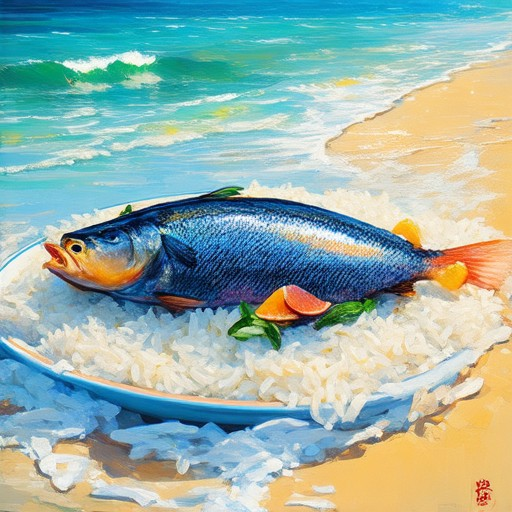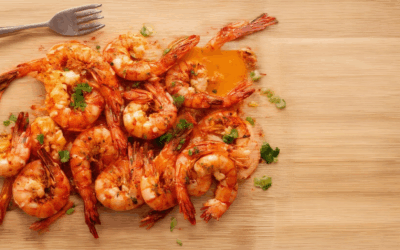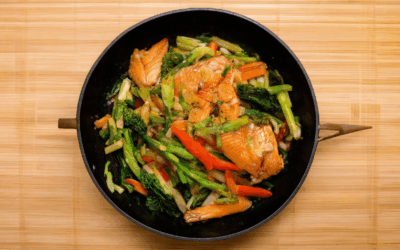Discover the perfect harmony of flavors with our collection of fish and rice recipes. Whether you’re a seasoned cook or new to the kitchen, these dishes offer a delicious balance of protein-rich fish and nutritious rice, crafted to delight your taste buds. From simple, wholesome meals to gourmet creations, we explore the versatility of fish and rice, highlighting the health benefits and culinary possibilities that make this duo a favorite worldwide. Learn why rice pairs so beautifully with fish, discover the ideal sauces to complement each dish, and dive into regional specialties like biryani and paella. With our expert tips and diverse recipe options, you’ll find endless inspiration to create memorable meals that are both satisfying and nutritious. Explore the world of fish and rice recipes today!
Key Takeaways
– Discover the traditional sushi dish called nigiri, featuring vinegared rice topped with raw fish.
– Understand the historical roots of pairing fish with rice, rooted in preservation methods.
– Learn how rice complements fish flavors, enhancing the taste of various seafood dishes.
– Recognize the cultural significance of rice as a staple alongside fish, offering a balanced meal.
– Grasp the nutritional benefits of combining fish with rice, supporting overall health.
– Notice the textural contrast between rice and fish, enriching the dining experience.
– Explore piscetarianism, a dietary choice allowing fish and white meats while excluding other meats.
– Identify common foods in a piscetarian diet, including fish, white meats, plants, and grains.
– See why piscetarianism is chosen for ethical, environmental, or health reasons.
– Correctly distinguish it from vegetarianism, noting its inclusion of fish and white meats.
– Appreciate the flexibility and balance offered by a piscetarian diet, promoting health and sustainability.

Is it Good to Eat Rice with Fish?
Yes, eating rice with fish is not only good but also a delicious and nutritious combination that has been enjoyed in various cultures around the world. Here’s why this pairing is beneficial:
- Nutritional Balance: Fish is an excellent source of high-quality protein, omega-3 fatty acids, and other essential nutrients. Rice complements this by providing carbohydrates, vitamins, and minerals. Together, they create a well-rounded meal that supports overall health.
- Flavor Enhancement: The mild, slightly sweet taste of rice pairs wonderfully with the rich, savory flavors of fish. Different types of fish can highlight the natural taste of the rice, creating a harmonious dish.
- Cultural Significance: In many Asian cuisines, rice is a staple accompanying fish dishes. From Japanese sushi to Indian biryani, this combination is celebrated for its versatility and comfort.
Popular Rice and Fish Dishes:
- Sushi Rolls: A classic Japanese dish featuring rice wrapped around fish, often salmon or tuna.
- Biryani: An aromatic rice dish cooked with meat, including fish, in the Indian subcontinent.
- Paella: A Spanish rice dish typically made with seafood, including fish or shellfish.
- Stuffed Fish: In some cuisines, rice is used to stuff whole fish before cooking, adding extra flavor and texture.
Health Considerations:
- Fish provides essential nutrients like vitamin D and selenium, which are beneficial for brain and heart health.
- Rice is a complex carbohydrate that helps manage blood sugar levels compared to simpler carbs.
- Together, they offer a balanced meal that fuels energy and supports daily activities.
How to Pair Them Perfectly:
- Choose complementary seasonings: Herbs, spices, and sauces that enhance both fish and rice without overwhelming either.
- Don’t overcook the rice: Al dente or slightly mushy depending on the dish, but always ensuring it absorbs flavors well.
- Experiment with different types of fish: Salmon, cod, tilapia, and catfish all pair well with rice.
Conclusion:
Eating rice with fish is not just a dietary choice—it’s a culinary delight that brings together two versatile ingredients into a satisfying meal. Whether you’re preparing an elaborate feast or a simple dinner, this combination is a winner for both taste and nutrition.
Explore more rice and fish recipe ideas .
What Sauce Goes Well with Fish and Rice?
There are several sauces that complement fish and rice beautifully, enhancing the flavors of both ingredients:
- Teriyaki Sauce : Perfect for salmon, tuna, and other Pacific fish. Its sweet and savory profile balances the richness of the fish and pairs well with rice.
- Soy Sauce : A versatile option that can be used as a dipping sauce or mixed into the rice. It adds a salty kick, complementing mild fish like tilapia or cod.
- Cilantro Lime Sauce : Ideal for lighter fish like trout or bass. Its fresh, citrusy taste brightens the dish, offering a tangy contrast.
- BBQ Sauce : Great for grilled fish such as swordfish or tuna. Its bold and smoky flavor enhances the char-grilled taste of the fish.
- Hollandaise Sauce : Best paired with smoked fish like salmon. Its creamy richness adds a luxurious element to the dish.
- Miso Sauce : Works well with fatty fish like salmon or mackerel. Its umami-rich flavor pairs harmoniously with rice, creating a satisfying combination.
- Sesame Oil : Can be drizzled over steamed fish or incorporated into the rice. Its nutty aroma enhances both components, adding depth to the meal.
- Sriracha Mayo : A spicy and creamy option ideal for shrimp or catfish. It adds a bold kick, balancing the heat with coolness.

What is a Fish and Rice Dish Called?
The dish you’re referring to is known as Kedgeree . This traditional recipe combines flaked fish, typically smoked haddock, with basmati rice, spices, and various ingredients like hard-boiled eggs, fried onions, and herbs such as parsley. Originating from Persian cuisine, Kedgeree is a popular dish in regions like the Middle East and South Asia, often served as a hearty breakfast or main meal. It is characterized by its rich, smoky flavor from the fish and the aromatic spices used in its preparation.

What is Just Fish and Rice Called?
Nigiri is the term used to describe a type of sushi that consists of an oval-shaped, hand-pressed mound of vinegared rice topped with a thin slice of raw fish or meat. Common toppings include tuna, salmon, yellowtail, and mackerel. This dish is often enjoyed as a standalone meal or as part of a larger sushi selection.
Why Is Fish Always Served with Rice?
Fish has been traditionally paired with rice due to several historical, cultural, and dietary reasons. Here’s a breakdown of the key factors:
- Preservation History : Originally, sushi was created as a preservation method where fermented rice was used to store fish. Although the rice was discarded, this practice laid the foundation for the traditional pairing of fish with rice in Japanese cuisine.
- Flavor Complementarity : Rice, particularly short-grain rice, has a mild, neutral flavor that complements the diverse range of fish varieties. Its ability to absorb flavors makes it an excellent base for marinating and seasoning fish dishes.
- Cultural Tradition : In many East Asian cultures, rice is a staple food. Its presence on the plate naturally accompanies protein-rich fish, offering a balanced and filling meal. This tradition has evolved into popular dishes like sushi, where rice is seasoned with vinegar, sugar, and salt to enhance the flavor profile of the fish.
- Nutritional Benefits : Pairing fish with rice provides a good source of carbohydrates, which complements the protein in fish. Brown rice, in particular, offers nutritional benefits like fiber and essential vitamins, making it a healthy addition to fish meals.
- Textural Contrast : The smooth, grainy texture of cooked rice contrasts nicely with the texture of fish, enhancing the overall dining experience. This textural aspect is particularly noticeable in dishes like sushi and sashimi.
Thus, the combination of historical practices, flavor compatibility, cultural habits, and nutritional advantages solidifies rice as a common and beloved accompaniment to fish worldwide.

What is it Called When You Only Eat Fish and White Meat?
The practice of consuming only fish and white meat is known as pescetarianism . This dietary choice involves incorporating fish and other white meats into meals while excluding all other types of meat, such as beef, pork, and chicken.
Foods Included in Pescetarian Diet
- Fish (e.g., salmon, tuna, cod)
- White meats (e.g., turkey, chicken, duck)
- Eggs
- Dairy products
- Plant-based proteins (e.g., beans, lentils, tofu)
- Vegetables
- Fruits
- Grains
Why Choose Pescetarianism?
Pescetarianism offers a flexible approach to eating, combining the health benefits of a vegetarian diet with the occasional inclusion of fish and white meats. It is often chosen for ethical, environmental, or personal health reasons.
Common Misconceptions
- It is not the same as vegetarianism, as it allows for fish and white meats.
- It does not exclude eggs or dairy, unlike strict vegetarianism.
This diet provides a balanced intake of nutrients while reducing reliance on land-based meats, making it an appealing option for many seeking a middle ground between vegetarian and omnivorous diets.




0 Comments